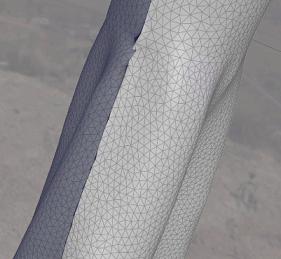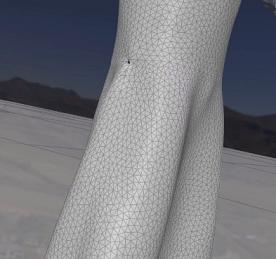| On this page |
Turning draped cloth into raw geometry ¶
Once you have draped your cloth you can either keep the constraints live for the succeeding simulation, or you can turn it into raw geometry. Turning the draped cloth into raw geometry will throw away any stiffness that’s been set, and will allow you to start with the geometry all over again. It also ensures there’s no more energy left in the system, and will leave you with a fresh new simulation to start with. Using a Vellum Post-Process is a great way to quickly weld points together. By default the Apply Welds checkbox is turned on. This will ensure there is only one point along the seams.
Note
This approach will bake in any wrinkles or curves in the draped cloth.
Note
Houdini displays backfaced triangles as blue. As a result, you may see the front panel of your clothing as white and the back panel as blue. To ensure you have a consistently wound system, without the contradiction of normals, you can add a Polydoctor node and turn on Correct Winding of Polygons to Majority of their Manifold Patch. However since there’s an equal number of polygons facing each direction, there is a 50/50 chance the dress will turn completely blue (making it inside out). If this happens, you can append a
Reverse SOP to flip the polygons the correct side out.


This can then be wired into the first input of a new Vellum Constraints node.
Some things to watch out for:
-
Make sure there are no conflicting ID attributes still around. For example, if you used ID point attributes and then merged some geometry together. This could result in duplicate IDs, which could cause problems when you're trying to solve your cloth simulation.
-
The Thickness is reset to the default (0.01) when a new Vellum Cloth is created, which may be too big for your geometry. You can either reset it to the desired value, or turn off the Thickness checkbox and use the value that is coming in from the source.
Things to consider when simulating cloth ¶
Substeps and Iterations
This will determine how stretchy the fabric is. For example 1 subestep per 100 iterations will generally make the cloth very stretchy. A good starting point for clothing is 5 substeps, because that gives the solver a chance to work on a smaller timestep, which helps it resolve the energy in a more realistic fashion.
Tailoring
Small alterations to the cloth could greatly improve the final look. For example, depending on the stride of your character, increasing the skirt width could prevent the garment from pulling at the bottom and give it a more interesting flow.
Static
Often your garment can move around on the character in an unrealistic way, like it’s floating. Increasing the static coefficient will cause the garment to stick more to the character.
Bend Strength
This parameter is what allows the individual triangles in the cloth to bend with respect to each other. A Bend Strength of 0 will result in lots of wrinkles, and a higher value will create a stiffer looking cloth.
Compression Stiffness
This parameter allows the triangles to collapse, but not expand. This prevents small micro-wrinkles, because instead of having to fold over the cloth can just compress in place. A high value for compression will result in lot of crinkly detail.
Tangent Stiffness
Turning on this parameter is useful when simulating pants or a skirt that’s attached to a character’s waist. Tangent stiffness holds the garment in place and prevents it from dropping or sliding down on the first frame due to gravity. It constrains the movement of the cloth in the direction tangent to the target geometry, and is better than decreasing the Rest Length Scale. It only works for Attach to Geometry constraints, which is Vellum geometry to external geometry, such as constraining cloth to a character’s body.
Stiffness Dropoff
This parameter reduces or increases the stiffness of a constraint as it moves away from the rest state. It’s useful for creating glue constraints that lose stiffness as they're stretched, or creating bend constraints that are weak to begin with and get stiffer as they bend away from their initial orientation. A Decreasing dropoff means that the stiffness starts at full strength and decreases to zero at the dropoff distance from the rest length. An Increasing dropoff means the stiffness starts at zero and increases to full stiffness at the specified distance from rest length.
Air resistance
Air flow is very important to have with cloth. No air flow will cause the cloth to fall flat and too much air flow will cause the cloth to look like it’s being dragged. The default value of 0.1 usually produces good results.
Gravity
Changing the gravity can make it appear as if time is going faster or slower. It can also affect scale, making things with lower gravity look bigger. Increasing gravity will also cause more stretching in the cloth, as stronger forces are pulling on it.